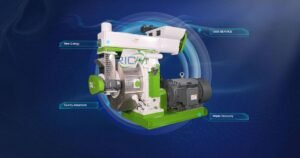Biomass materials are increasingly used in fertilizer pellet production due to their abundance, sustainability, and potential to enhance soil health. However, these materials often require several preprocessing steps before they can be effectively incorporated into fertilizer pellets. This article explores the essential preprocessing steps for biomass materials in fertilizer pellet production.
- Collection and Sorting
The first step in utilizing biomass for fertilizer pellets is proper collection and sorting:
- Source Separation: Ensure that different types of biomass (e.g., agricultural residues, wood waste, animal manure) are collected separately to maintain quality control.
- Contaminant Removal: Remove any non-organic materials such as plastics, metals, or stones that could interfere with the pelletization process or contaminate the final product.
- Quality Assessment: Evaluate the collected biomass for moisture content, nutrient composition, and potential pathogens to determine appropriate preprocessing needs.
- Size Reduction
Most biomass materials need to be reduced in size for efficient pelletization:
- Chopping: Large materials like crop stalks or wood chips are initially chopped into smaller pieces.
- Grinding: A hammer mill or similar equipment is used to grind the chopped material into a fine, uniform size.
- Screening: The ground material is screened to ensure consistent particle size, typically between 2-8 mm for optimal pelletization. (Related post: sheep manure granule machine)
- Drying
Moisture content is critical in pellet production. Most biomass materials require drying:
- Natural Drying: Spreading biomass in thin layers for sun drying, suitable for small-scale operations.
- Mechanical Drying: Using rotary drum dryers or belt dryers for large-scale, consistent drying.
- Optimal Moisture: Aim for a moisture content of 10-15% for most biomass materials to achieve proper pellet formation.
- Composting (for certain materials)
Some biomass materials benefit from composting before pelletization:
- Microbial Breakdown: Composting helps break down complex organic compounds, making nutrients more available.
- Pathogen Reduction: The heat generated during composting can eliminate harmful pathogens.
- Odor Reduction: Composting can significantly reduce odors associated with certain biomass materials like animal manure.
- Nutrient Analysis and Adjustment
Understanding and adjusting the nutrient content is crucial:
- Laboratory Testing: Analyze the preprocessed biomass for macro and micronutrient content.
- Nutrient Balancing: Add supplementary nutrients if necessary to meet desired fertilizer specifications.
- pH Adjustment: If required, adjust the pH of the biomass to optimize nutrient availability in the final product.
- Mixing and Homogenization
Proper mixing ensures a consistent final product:
- Blending: Combine different types of preprocessed biomass if using multiple sources.
- Additive Incorporation: Mix in any additional nutrients, binding agents, or other additives uniformly.
- Homogenization: Use ribbon blenders or paddle mixers to achieve a homogeneous mixture.
- Conditioning
Conditioning prepares the biomass for optimal pelletization:
- Steam Conditioning: Adding steam can help activate natural binders in the biomass and improve pellet durability.
- Temperature Control: Maintain the biomass at an optimal temperature (typically 60-80°C) to enhance binding properties.
- Moisture Adjustment: Fine-tune the moisture content immediately before pelletization, usually to 15-20%. (Related post: pig manure fertilizer pellet machine)
- Sterilization (if necessary)
For certain applications, sterilization may be required:
- Heat Treatment: Using high temperatures to eliminate potential pathogens.
- Chemical Treatment: In some cases, approved chemical treatments may be used to ensure the safety of the final product.
- Storage and Handling
Proper storage of preprocessed biomass is crucial:
- Dry Storage: Keep preprocessed biomass in dry, well-ventilated areas to prevent moisture absorption and mold growth.
- Batch Separation: Maintain separation between different batches or types of preprocessed biomass.
- First-In-First-Out (FIFO): Implement a FIFO system to ensure older materials are used first.
- Quality Control
Throughout the preprocessing steps, maintain rigorous quality control:
- Regular Testing: Conduct frequent tests on moisture content, particle size, and nutrient composition.
- Documentation: Keep detailed records of each batch, including source, processing steps, and test results.
- Adjustment: Be prepared to adjust preprocessing parameters based on quality control findings.
Conclusion
The preprocessing of biomass materials for fertilizer pellet production is a multi-step process that requires careful attention to detail and quality control. Each step, from collection and sorting to final conditioning, plays a crucial role in ensuring the production of high-quality, effective fertilizer pellets.
By following these preprocessing steps, manufacturers can transform various biomass materials into valuable components of fertilizer pellets. This not only helps in recycling organic waste but also contributes to the production of sustainable, environmentally friendly fertilizers that can enhance soil health and crop productivity.
As the demand for sustainable agricultural practices grows, the use of properly preprocessed biomass in fertilizer pellets represents an important step towards more efficient resource utilization and circular economy principles in agriculture. Manufacturers who master these preprocessing techniques will be well-positioned to meet the increasing demand for eco-friendly fertilizer products in the global market.
For details please contact: pellet maker machine
WhatsApp:86 138 3838 9622
Email:enquiry@richipelletmachine.com



